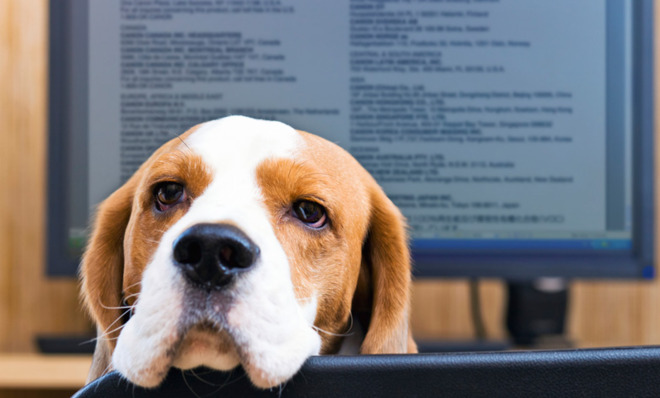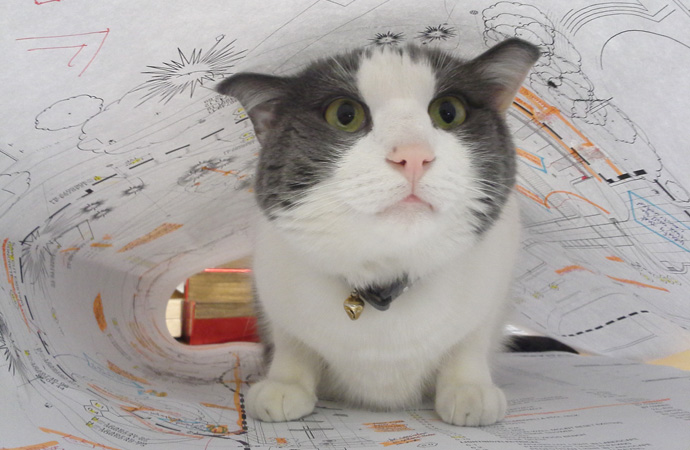5 reasons pets are great for the workplace
Rover and Mittens could be the key to higher productivity

The idea that pets are good for workplace productivity is counterintuitive: Pets are noisy and rambunctious, and they need to be fed, walked, and cuddled throughout the day. If anything, they sound like they would distract from work.
Yet a growing number of companies, from Ben & Jerry's to Google, are allowing employees to bring their pets to work. Some, like Village Green, a Detroit-based property management company, actually pay workers to bring their pets to work.
Here, five ways pets can improve the workplace:
The Week
Escape your echo chamber. Get the facts behind the news, plus analysis from multiple perspectives.

Sign up for The Week's Free Newsletters
From our morning news briefing to a weekly Good News Newsletter, get the best of The Week delivered directly to your inbox.
From our morning news briefing to a weekly Good News Newsletter, get the best of The Week delivered directly to your inbox.
They lower stress levels
Many work environments are inherently stressful: There are deadlines and quotas to meet, bosses and coworkers to please, and often very little sunlight and opportunity to get out from behind the computer screen. All these factors can elevate stress and lower workplace satisfaction, taking a bite out of worker productivity.
The antidote to all that stress? Research shows that four-legged furry friends can be of great help.
Recent studies in hospitals and nursing homes have shown the powerful effect animals can have on human health. Interspecies interaction can contribute to lower blood pressure, relief from depression and anxiety, and even faster recovery after surgeries. Similar benefits have been proven in the office setting, too.
A free daily email with the biggest news stories of the day – and the best features from TheWeek.com
In 2012, a Virginia Commonwealth University study took a look at a 550-person manufacturing-retail office in Greensboro, N.C., where about 20 to 30 dogs came to work each day, says Science Daily. Using surveys and saliva samples to evaluate stress levels, researchers found that self-reported stress declined throughout the day for employees who brought their pets to the office.
Meanwhile, those who left their dogs at home experienced an increase of self-reported stress throughout the day. By the end of the day, the group had "significantly higher stress" than the group with dogs.
They help break the ice
Like a cute baby or an offensive T-shirt, pets have a way of instigating conversation among humans. This can be clutch in the modern workplace, where many employees interact only through screens, and offices can be quiet, except for the noisy typers.
Pets pull people away from their screens long enough to answer questions about, well, their pets — the breed, the story behind the name, etc. These face-to-face conversations can help team members bond and boost morale.
A 2010 study out of the University of Central Michigan showed how pets can foster bonding in the workplace:
The CMU study involved several experiments; one involving groups of four individuals, some with or without dogs. Each group member was charged with a fake crime, and surveyed to see if they would report their fellow group members. Groups with dogs present made employees 30 percent less likely to report each other, showing that canine co-workers make for a more cohesive and trustworthy workplace environment. [The Humane Society]
They force breaks
Most jobs don't require workers to take breaks, and in a competitive, fast-paced environment, that can mean full days where workers don't leave their desks for more than the occasional trip to the water cooler.
Having a dog in the office requires the owner to occasionally peel herself away from her computer and take the dog for a walk, essentially forcing a break.
Though it sounds counterintuitive, these breaks can boost productivity. Studies show that sustained mental effort over multiple hours, like the kind required for data entry jobs, for example, can cause mental fatigue and stress, resulting in more mistakes and lower productivity. Occasionally breaking away, however, can boost focus and creativity, and lower mistakes.
It also helps that the dog owners are taking the breaks outside and moving around — also good for mental clarity.
They remove pests for free

At Civitas, an urban design, planning, and landscape architecture firm in Denver, a gray and white cat named Gonzo performs a vital task: Mice removal.
"The mice came back when the cat before him died, but disappeared again when Gonzo showed up," says Amirah Shahid, a landscape architect at the firm. "He recently left a dead mouse carcass as a present at someone's desk."
Beyond the free gifts, the cat means not having to hire an exterminator to spray chemicals around the office.
The decor
Another benefit: Some cats and dogs can make the space more attractive. "[Gonzo's] very handsome to look at," says Shahid. "And he makes us take much needed breaks to acknowledge his presence when he's making his rounds around the studio."
"Clients, consultants, and other office visitors think we're super cool because we have him roaming around."
Carmel Lobello is the business editor at TheWeek.com. Previously, she was an editor at DeathandTaxesMag.com.
-
 Homes with great fireplaces
Homes with great fireplacesFeature Featuring a suspended fireplace in Washington and two-sided Parisian fireplace in Florida
-
 Is $140,000 the real poverty line?
Is $140,000 the real poverty line?Feature Financial hardship is wearing Americans down, and the break-even point for many families keeps rising
-
 Film reviews: ‘The Secret Agent’ and ‘Zootopia 2’
Film reviews: ‘The Secret Agent’ and ‘Zootopia 2’Feature A Brazilian man living in a brutal era seeks answers and survival and Judy and Nick fight again for animal justice